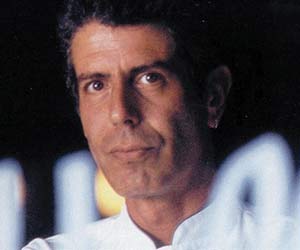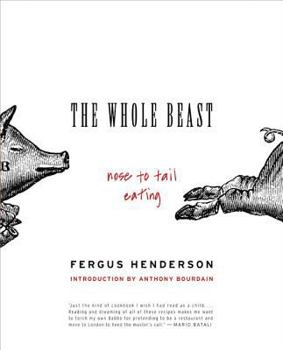The Whole Beast: Nose to Tail Eating
Select Format
Select Condition 
Book Overview
The Whole Beast: Nose to Tail Eating is a certified "foodie" classic. In it, Fergus Henderson -- whose London restaurant, St. John, is a world-renowned destination for people who love to eat "on the wild side" -- presents the recipes that have marked him out as one of the most innovative, yet traditional, chefs. Here are recipes that hark back to a strong rural tradition of delicious thrift, and that literally represent Henderson's motto, "Nose...
Format:Paperback
Language:English
ISBN:0060585366
ISBN13:9780060585365
Release Date:March 2004
Publisher:Ecco Press
Length:224 Pages
Weight:0.72 lbs.
Dimensions:0.6" x 7.3" x 9.2"
Related Subjects
Cooking Cooking English, Scottish & Welsh European Holiday Cooking Meat, Poultry & Seafood MeatsCustomer Reviews
5 ratings
Delicious Indictment of our Wastefulness
Published by Thriftbooks.com User , 17 years ago
I have to start by saying that I can prepare only ten of the thirty-four recipes in the meat section of this cookbook without special ordering, and thirteen are virtually impossible due to unavailability of ingredients. Lamb tongues? Pig tails? Quarts of pig blood? Lamb hearts? Forget it. I live near a large butcher who can't or won't provide any of these items for any price I can pay. They go to the dogfood plants. This is a pity, as anyone lucky enough to have eaten the flavorful extremities and innards of young animals can attest. Our American supermarket meat counters have for years whittled down the selection in favor of the most flavorless cuts: fillet mignon and chicken breast have taken the shelf space once dedicated to the "set of delights, textural and flavorsome, which lie beyond the fillet", to quote author Fergus Henderson. As our cultural memory of the flavors of the parsimonious and creative farmhouse kitchen shrivels, our food is impoverished. Henderson writes a sharp critique of our culture of waste, but only as the byproduct of his central thesis: that there is a world of pleasure out there for those who set aside their suburban sqeamishness and eat the whole beast. Among the few recipes I can follow without unconscionable substitutions are some real gems. Tripe and Onions, remarkably similar to French, Italian, Spanish, and even Mexican preparations, is delicious. Rabbit and Garlic is a powerfully aromatic feast. Beans and Bacon is a perfect rustic dish, a worthy simplification that could stand for cassoulet. Ox Tongue and Bread, really a carpaccio or hearty salad, is an excellent meal on its own, great with a simple and light red table wine. Each time I've prepared a dish from this book, I've lamented the narrow-minded marketing that makes most of the book inaccessible. My laments are accompanied by shameless keening when I get to the Birds and Game section. Almost nothing in this section is possible here. A shame, really. Some of these recipes make great reading. But so did Don Quixote, and I'm not any more able to get fresh pigeon [without a good slingshot] than I am able to book a flight to medieval Spain. This highlights the real perversity of this book: af all the many cookbooks in my library, representing such far-flung cuisines as Indian, Turkish, and West African, the most exotic is from my ancestral England, from a chef who speaks something very like my own language, and whose ingredients sound, but for the specific location of their cuts, very familiar. How far we've come without true progress! Go to the meat counter and test this assertion: our culture values two characteristics above all others in meat: softness and blandness. Now consider what we're missing: the heady pleasures of the most flavorful cuts of meat, skillfully prepared and simply served. Somewhere along the way we've abandoned a great cultural inheritance. It takes an act of will to remember that abundance has cost us
The Ultimate Healthy Diet
Published by Thriftbooks.com User , 19 years ago
Kudos to The Whole Beast by Fergus Henderson. This unusual cookbook is dedicated to recipes on organ meats. The delicious array includes warm pig's head, ox tongue, roast bone marrow, calf's heart, brawn (headcheese), jellied tripe, rolled pig's spleen, duck neck terrine, duck hearts on toast, many recipes for lamb's brain, sweet breads, blood cake (made with 1 quart of pig's blood), pig's cheek and tongue, gratin of tripe, haggis, deviled kidneys, lamb's kidneys and giblet stew. The one notable omission is steak and kidney pie. The recipes are exotic (or so they seem to us-they were once standard fare for Britons) but also simple. Henderson's signature dish is Roast Bone Marrow and Parsley Salad, which calls for marrowbone, parsley, shallots and capers, with a dressing of lemon juice and olive oil-that's all. The ingredient list for Duck Hearts on Toast is minimal: duck hearts, chicken stock, balsamic vinegar, salt, pepper, butter and toast. Many pages are devoted to preserving meats, including an intriguing recipe for dried salted pig's liver. Others include brine-cured pork belly, corned ox tongue, cured beef or venison, pickled herring and a variety of animal parts preserved in rendered fat. And the book contains other treasures: many recipes for game birds, rabbit, venison, crab, eel, mussels and salt cod; creative vegetable concoctions, wonderful soups and unusual salads. Henderson understands the value of stocks, makes pastry crust with suet and uses real butter and cream. Henderson includes no discussion of the health benefits of the foods he serves, but with the exception of white sugar used in a few dessert recipes, and white bread crumbs in a few soups recipes, The Whole Beast is the quintessential health food cookbook; its principles will confer more beauty, strength and happiness on mankind than the thousands of fatuous lowfat tomes that lecture us about the evils of rich diets and promise the mecca of good health on a diet of skinless chicken breasts and soy smoothies. Critics contend that Henderson's food is too extreme for Americans. Henderson replies: "My experience is that every time someone comes to the kitchen at St. John to say how much they enjoyed our Pig's Head or Rolled Spleen, they are always American, so I have no doubt that the strong gastronomic spirit of adventure in the United States will carry them through the recipes in this book." Whether you are a timid eater or a courageous one, this book needs to be in your kitchen, and not kept pristine on the shelf, but reverently used. You'll need to find a real butcher or a farmer to obtain many of the basic ingredients, which is all the better, because as we learn to eat the whole beast, we hasten the revolution that is underway in America: the return to real food produced on real farms. Review by Sally Fallon
Great Modert Treatment of Very Old Techniques. Outstanding
Published by Thriftbooks.com User , 20 years ago
Fergus Henderson, the chef author of this book subtitled `nose to tail eating' is a cult hero among foodies and among heroes of foodies such as Tony Bourdain, who writes the introduction to this new edition and Mario Batali, a major advocate himself of using the whole animal.For several reasons, this book is likely to have little to no value to the average person who cooks and who may refer to a cookbook now and then. The recipes commonly use ingredients that are simply unavailable outside better butcher shops and farmers' markets. The recipes also commonly use techniques that are the antithesis of fast cooking and low fat cooking. There are some recipes that literally require up to two weeks to complete.The true audience for this book aside from culinary professionals are those who religiously watch Alton Brown's `Good Eats' , read John Thorne's books and newsletter as if they were gospels, and study books by Paul Bertolli, Eric Rippert, Judy Rodgers, and Jeremiah Tower for subtle new techniques to squeeze the last ounce of value from their primo materia.Just to be sure it is clear to you what this book is all about, it's primary subject is preparing in a cuisine absolutely everything but the oink, as the saying goes, from a pig and other animals. To this end, the author presents us with recipes for pig's head, pigs jowls (Mario Batali's favorite guanciale), pig's ears, pig's tail, livers, hearts, tongues, and the most beloved stomach as used in preparing the old Scottish classic, haggis.If this were the limit of the author's novelty, there would probably be little interest in the book among chefs. The author pushes this point of view to cover culinary techniques which are either not commonly used by the average chef and which are generally unknown to the average cook. The two best-known methods are brining and preserving in oil as in a comfit. Brining has probably become much better known among American foodies thanks to the efforts of Alton Brown and Shirley Corriher. It is a method of soaking meat in a solution of salt, sugar, and aromatics to impart moisture to the meat. Creating a comfit involves storing meat in fat rendered from the meat and fatty parts of the animal from which the meat was taken. The method is best known as a method for preserving duck legs, but it may be applied to many other meats. The author applies both techniques to a wide variety of foods.If any part of this book may have use to the average reader who takes cooking seriously, it would probably be the author's lessons on the creation and use of stocks. Unlike chefs at the cutting edge of American haute cuisine such as Judy Rodgers, Henderson's stock techniques are beautifully simple. He does recommend the uncommon method of creating a raft to clarify stocks. I have not seen this method used outside of Culinary Institute of America texts, but the author presents it so simply that one need have no fear that it is too complicated for them. That is not to say it does not
Extraordinary Book Extraordinary Chef
Published by Thriftbooks.com User , 20 years ago
This book is centuries behind its time and years ahead of its time-a great book for anyone who cares about food, cooking or eating. Thank God for Henderson's work and craft. He's a marvel. More people in the United States ought to be familiar with his work. I hope this book is just the beginning.
The Cult Classic--A Masterpiece
Published by Thriftbooks.com User , 20 years ago
Recipes from my very favorite restaurant on earth.Finally..FINALLY, Fergus Henderson's amazing book is reprinted in the US--allowing American chefs and foodies to lay their hands on what they've only been hearing about for years. Don't be put off by offal--this is a fine, British country-style cookbook filled with useful, easy-to execute regional Brit fare. And as a food-nerd collectible--its the ultimate must-have. I've said elsewhere that the publication of this book is the most important event in food publishing this year--and I meant every word.
The Whole Beast: Nose to Tail Eating Mentions in Our Blog

Portrait of a Culinary Rock Star
Published by Ashly Moore Sheldon • June 25, 2020
Today, Anthony Bourdain would have turned 64. Two years ago, the celebrity chef and author shocked many when he took his own life while on location in France shooting his TV show Parts Unknown. Here we remember the famously insurgent character who did everything on his own terms.




